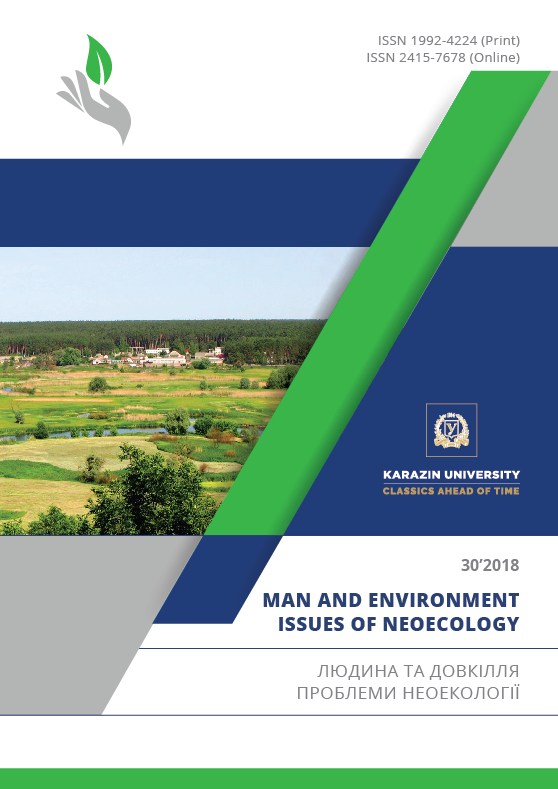Postpyrogenic Development of Young Pine Stand in Forest-Steppe
Abstract
Purpose of the work is to study the response of the radial growth of pine in the young to the effects of fires. Methods. Comparative ecological methods, taxation, standard dendrochronological methods, statistical, correlation and regression analyzes were used. Results. The study was conducted in a clean, young pine stand, which was damaged by wildfire in 2011. The wildfire occurred in favorable weather conditions (the vegetation season was warm and humid), which led to mitigating the effects of fire on the plantings. It was revealed that the radial increment of damaged trees in the year of wildfire (2011) was less than the tree rings at the control by 20%. During 2012-2017 increase of the radial growth of damaged trees was revealed because about 30% of trees were drying and living trees got extra light and reveal. Radial growth of survived trees reached the level as before the wildfire. Late wood responded faster to fire damage. Conclusions. The wildfire led to the death of weakened trees, significantly speeding up the process of natural thinning of the stand. The recovery of the radial growth of surviving trees occurred in 2014. Restoration of the radial growth of trees, survivors, occurred in 2014. It is advisable to use the proportion of late wood to assess the state of plantations after a wildfire.
Downloads
References
Bitvinskas, T.T. (1974). Dendroklimaticheskie issledovaniya [Dendroclimatic studies]. Leningrad: Gidrometeoizdat, 172 [in Russian].
Voron, V. P., Koval`, I. M., Tkach, O. M., Sy`dorenko, S. G. (2017). Zminy` radial`nogo pry`rostu v poshkodzhenomu pozhezheyu sosnovomu derevostani v Polissi [Changes of radial growth in pine stand damaged by fires in West Polissy]. Scentific Bulletin of UNFU, (27/9), 56-59 [in Ukrainian].
Voron,. V.P., Koval`, I.M. (2011). Vply`v ny`zovy`x pozhezh ga dy`namiku radial`nogo pry`rostu sosny` v lisostepovij zoni Ukrayiny`[ Influence of ground fire on dynamic of pine radial growth in forest steppe zone of Ukraine]. Scentific Bulletin of UNFU, (21.7), 45-50 [in Ukrainian].
Zibcev, S.V., Borsuk, O.A. (2012). Oxorona lisiv vid pozhezh u sviti ta perspekty`vy` rozvy`tku. Lisove i sadovo-parkove gospodarstvo, [Protection of forests frcom fires in the world and Ukraine – challenges in XXI century]. Scentific Bulletin of NUBiP, (1), 49-63 [in Ukrainian].
Koval`,I. M., Brauny`ng, A., Voronin, V. O., Nevmy`vaka, M. A., Tokareva, N. A. (2018). Osobly`vosti for-muvannya shariv rann`oyi, pizn`oyi ta richnoyi derevy`ny` duba zvy`chajnogo v nasadzhenni Livoberezhnogo Lisostepu Ukrayiny` [Features of the formation of early, late wood and tree ring width in the stand of the Left Bank Forest-steppe of Ukraine]. Bulletin of of scientific articles of the XIV -Ukrainian scientific Talyev readings, 61-64 [in Ukrainian].
Koval`, I.M. (2010). Radial`ny`j pry`rist yak indy`kator stijkosti lisovy`x ekosy`stem na pry`kladi sosnovy`x lisiv zelenoyi zony` m. Xarkova [Radial growth as an indicator of the stability of forest ecosystems on the example of pine forests of the green zone of the Kharkiv city]. Scentific Bulletin of NUBiP, (147), 223 – 232 [in Ukrainian].
Koval , І.М.(2001) Changes of Pine radial growth increment under air pollution influence in the Steppe zone of Ukraine. Conference «EURODENDRO-2001». Ljubljana, Slovenia, 24-25 [in English].
Koval`, I.M., Bologov, O.V., Nusbaum, S. A., Yuzvy`ns`ky`j, G.A. (2015). Radial`ny`j pry`rist duba zvy`chajnogo ta yasena zvy`chajnogo yak indy`kator stanu lisovy`x ekosy`stem v umovax Novograd-Voly`ns`kogo fizy`ko-geografichnogo rajonu. [Radial increment of oak and ash trees as indiacator of forest ecosystems conditions inNovograd-volysky phisiographic region]. Scentific Bulletin of Forestry and Forest Melioration, (126), 202-211 [in Ukrainian].
Koval`, I.M., Kostyashkin, D.S. (2015) Vply`v klimatu ta rekreaciyi na formuvannya shariv richnoyi derevy`ny` rann`oyi ta pizn`oyi form Quercus Robur L. U zelenij zoni m. Xarkova. [The influence of climate and ecreation on formation of layers of annual wood of Early and late for Quercus Robur L. in Kharkiv Greenbelt]. Scentific Bulletin of NUBiP, (25.6), 52-58 [in Ukrainian].
Koval`, I.M., Tokareva, N.A., Nevmy`vaka, M. O., Vorony`n ,V. O. (2016). Dy`namy`ka radial`nogo pry`rostu derev, poshkodzheny`x pozhezheyu, v sosnovy`x lisax Lisostepovoyi zony` Xarkivshhy`ny`. [Dynamic of radial growth trees damaged by fire in pine stands steppe zone of Kharkiv region]. Visnyk of V. N. Karazin Kharkiv national university series «Ecоlogy», (15), 81-88 [In Ukrainian]. [in Ukrainian].
Nikolaev, A.N. (2010).Dendrohronologicheskie issledovaniya poslepozharnoj reakcii drevesnyh porod v Central'noj YAkutii. [Dendrochronological studies of the post-fire reaction of tree species in Central Yakutia]. Izvestiya Samarskogo nauchnogo tsentra Rossiyskoy akademii nauk. 12, (1(3)), 888-891 [in Russian].
Khodakov, V.E., Zharikova, M.V., Grin, D.S. (2011) Forest fires: research methods. Kherson, 470 [in Rus-sian].
Koval, I. M., Bräuning, A., Melnik, Е. E., Voronin V. O. (2017). Dendroclimatological research of scots pine in stand of the left-bank forests-steppe of Ukraine. Man and environment. Issues of neoecology, (3-4/28), 66-73 [in English].
Koval, Iryna (2017). The radial growth of European ash in Forest-Steppe Zone of West Ukraine. Book of Abstracts EuroDendro 6-10 September. Tartu, Estonia, 90 [in English].
Methods of Dendrochronology. Applications in the Environmental Sciences (1990) Edward R. Cook and Leonardas A. Kairiukstis (eds). – Doredrecht, the Netherlands : Kluwer Academic Publishers and International Institute for Applied Systems Analysis, 394 [in English].
Authors reserve the right of attribution for the submitted manuscript, while transferring to the Journal the right to publish the article under the Creative Commons Attribution License 4.0 International (CC BY 4.0). This license allows free distribution of the published work under the condition of proper attribution of the original authors and the initial publication source (i.e. the Journal)
Authors have the right to enter into separate agreements for additional non-exclusive distribution of the work in the form it was published in the Journal (such as publishing the article on the institutional website or as a part of a monograph), provided the original publication in this Journal is properly referenced
The Journal allows and encourages online publication of the manuscripts (such as on personal web pages), even when such a manuscript is still under editorial consideration, since it allows for a productive scientific discussion and better citation dynamics (see The Effect of Open Access).





